Today we do classic klepe, traditional Bosnian ravioli-style dumplings stuffed with ground beef. These delicious, beef dumplings are first shaped (their manti-like dumpling dough is made from scratch and without baking powder), quickly boiled, and finally baked, all while swimming in two mouthwatering sauces. You in?
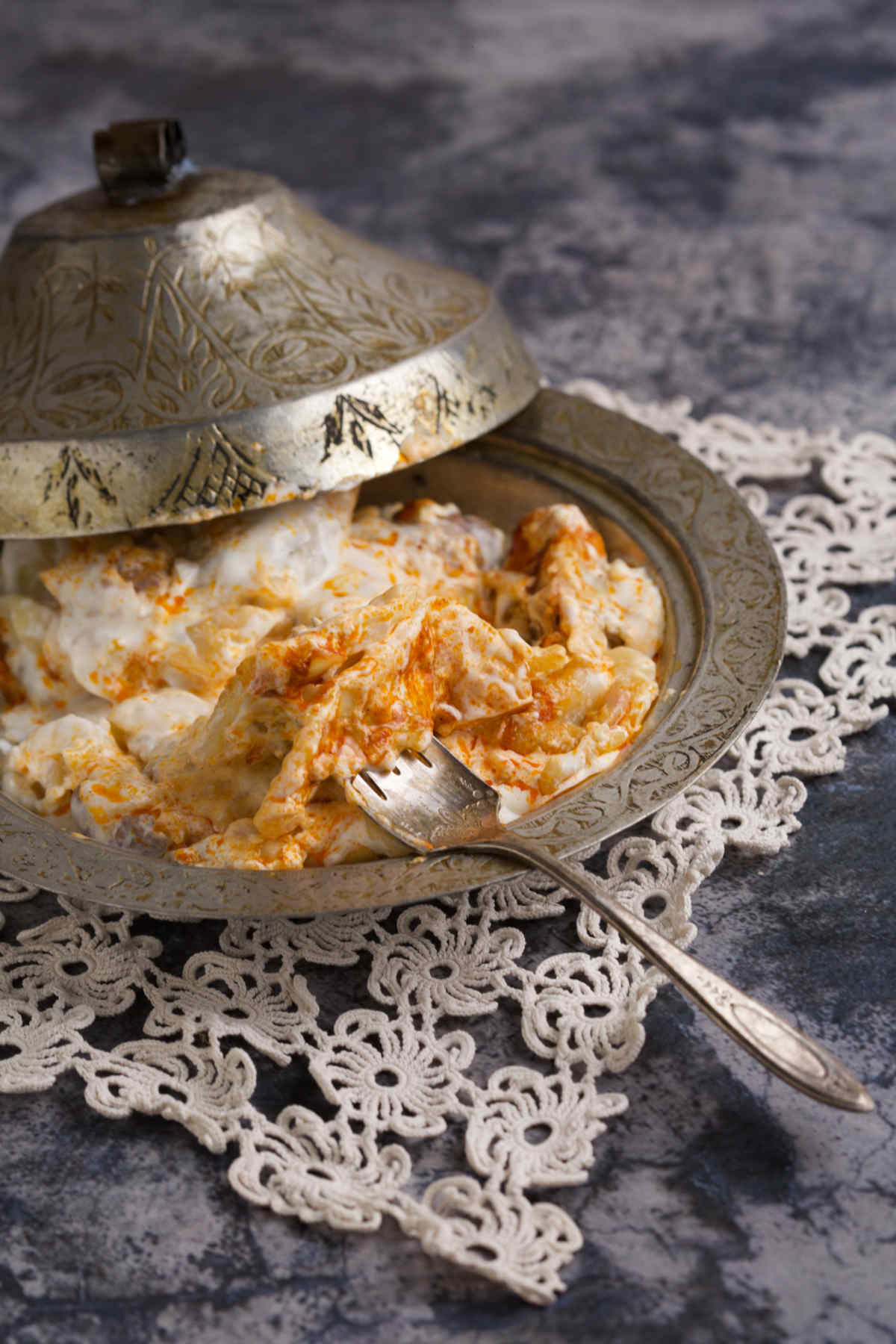
Jump to:
Background
Most cultures have some version of dumplings in their cuisine. While the Balkan kitchen boasts a few, some of the best regional dumplings are known as klepe or kulaci. (We will be using klepe and dumplings interchangeably in text.)
Here, we're bringing you the best of the best: recipe for the traditional Bosnian klepe.
Think of Bosnian klepe dumplings as something between Turkish manti and Italian ravioli.
- What sets klepe apart from manti dumplings is that they're usually larger, and shaped as crescents (or triangles).
- What sets them apart from ravioli is heavy, and sour cream sauce (instead of a tomato-based one). Sometimes, like today, these beef dumplings also come with additional butter, paprika, and garlic topping.
The dough for Bosnian (Balkan) dumplings is made from scratch, and without baking powder (or other leavening agents).
The stuffing consists of cheese, spinach, or meat. As mentioned, this recipe is for the beef dumplings, as those are the classics.
Ingredients
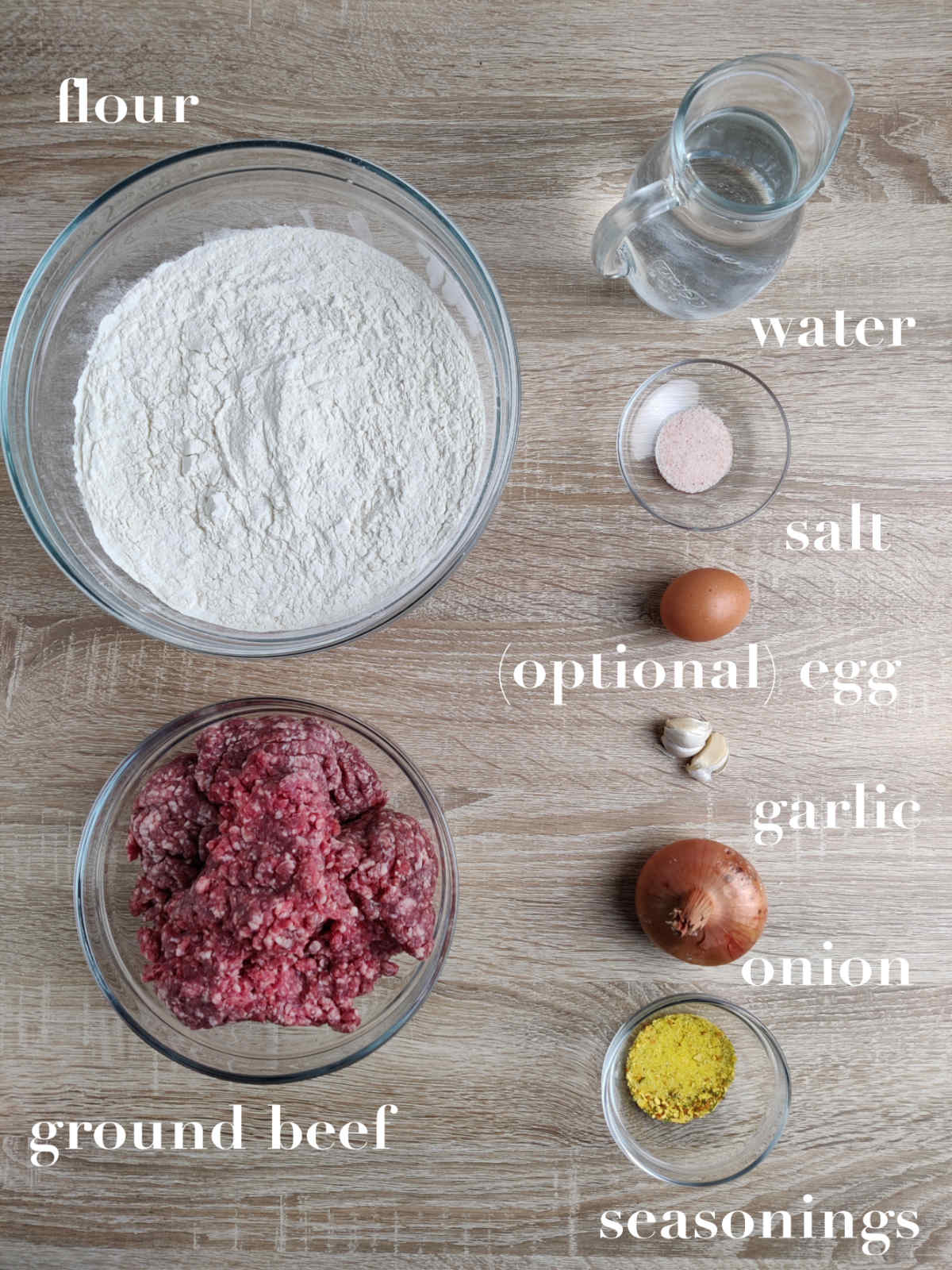
Klepe (beef dumplings) dough and filling:
- Flour: regular, white flour. Do not substitute.
- (Optional) egg: some like to add an egg to the dough. We don't find it necessary.
- Seasonings: klepe call for the simplest of seasonings. We're talking salt, pepper, and (optional) beef bouillon or Vegeta.
- Onion: minced finely, or grated. If grating, squeeze the liquid before adding to the filling as it may become soggy. You want to avoid biting into an onion while eating klepe. Onion is there for the taste, not to be tasted.
- (Optional) garlic: minced or grated. As garlic also goes into the topping sauce, feel free to omit it in the meat. If you're a hardcore 'garlicholic,' then put it in the meat too.
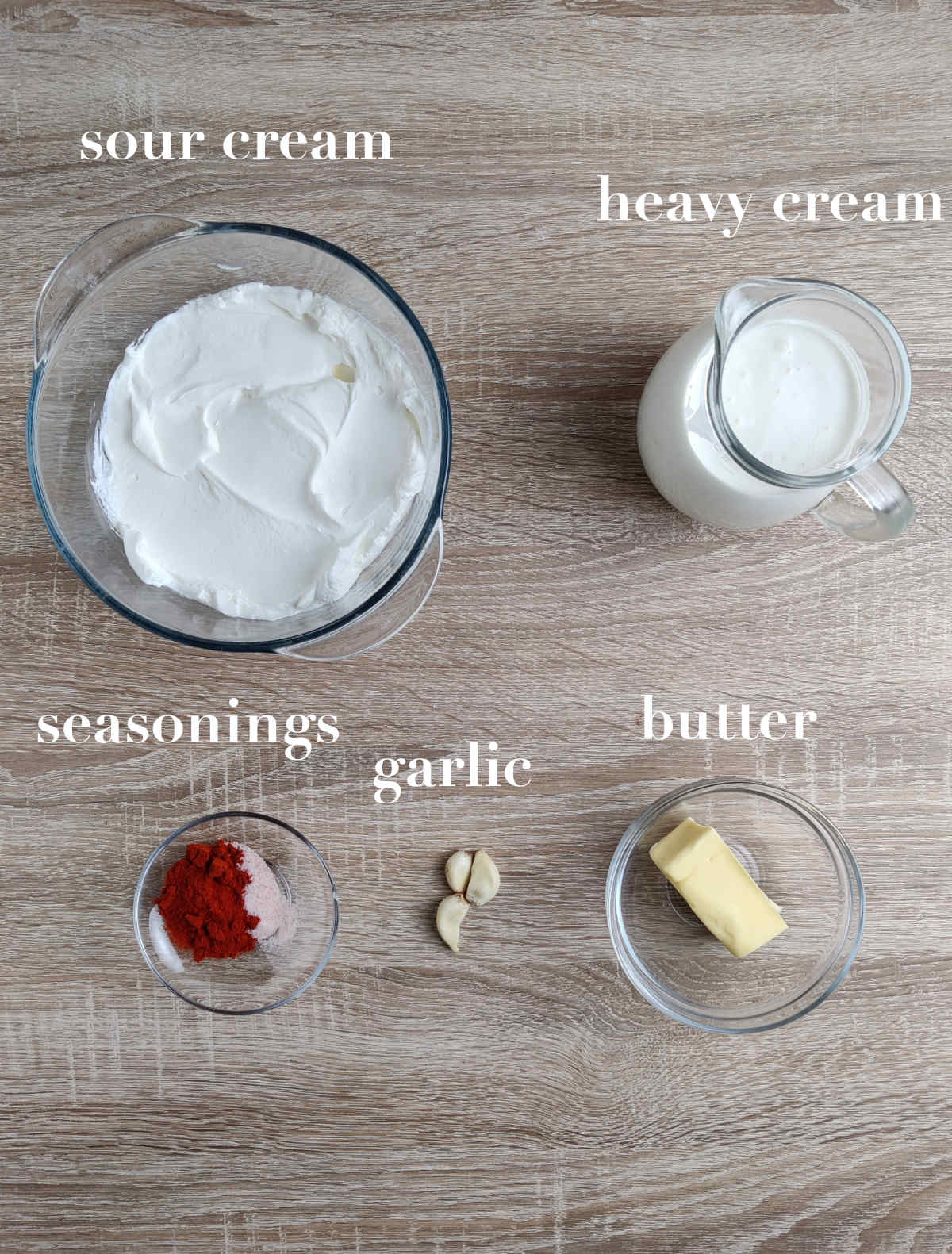
Klepe (beef dumplings) sauces:
- Sour cream: regular. Low fat also works.
- Heavy cream: substitute with half and half, but use ⅔ the volume, and add more sour cream.
- Butter: melt butter slowly with garlic and paprika.
- (Optional) parsley: mince and add to sauce 2 after you pour it over the dumplings.
Instructions
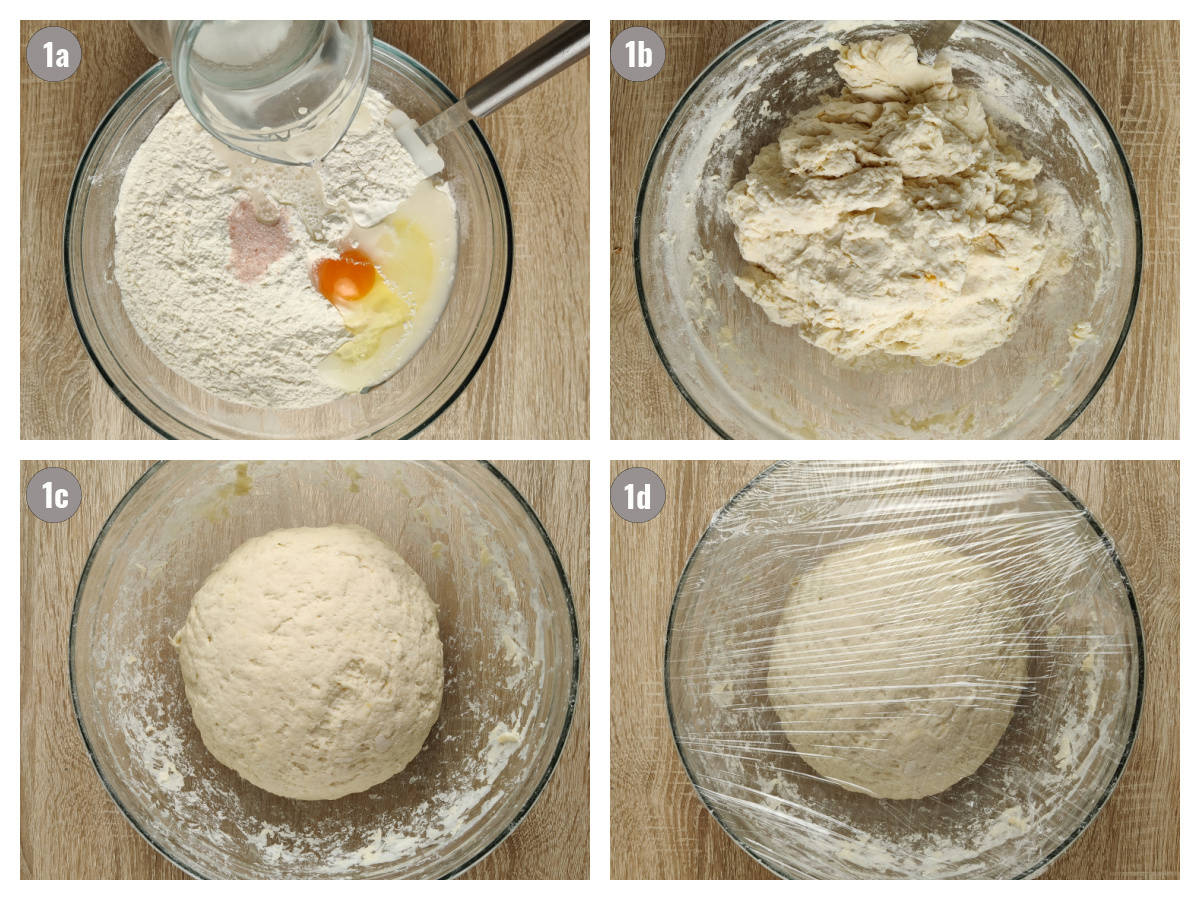
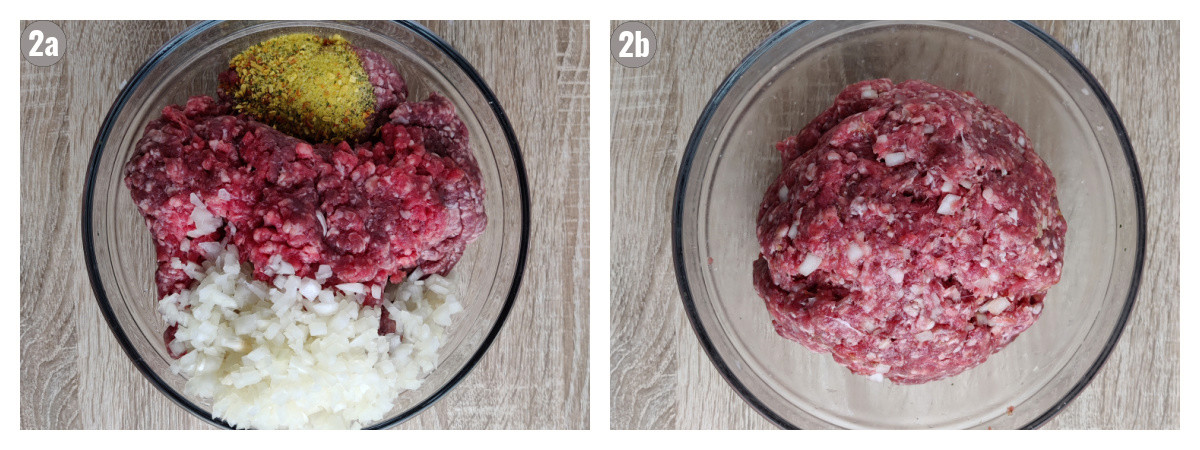
1. and 2. (Klepe (beef dumplings or Bosnian ravioli) dough) Make a dough ball. Cover with saran wrap. Let it rest. (Klepe filling) Combine filling ingredients until integrated. Divide into three equal parts.
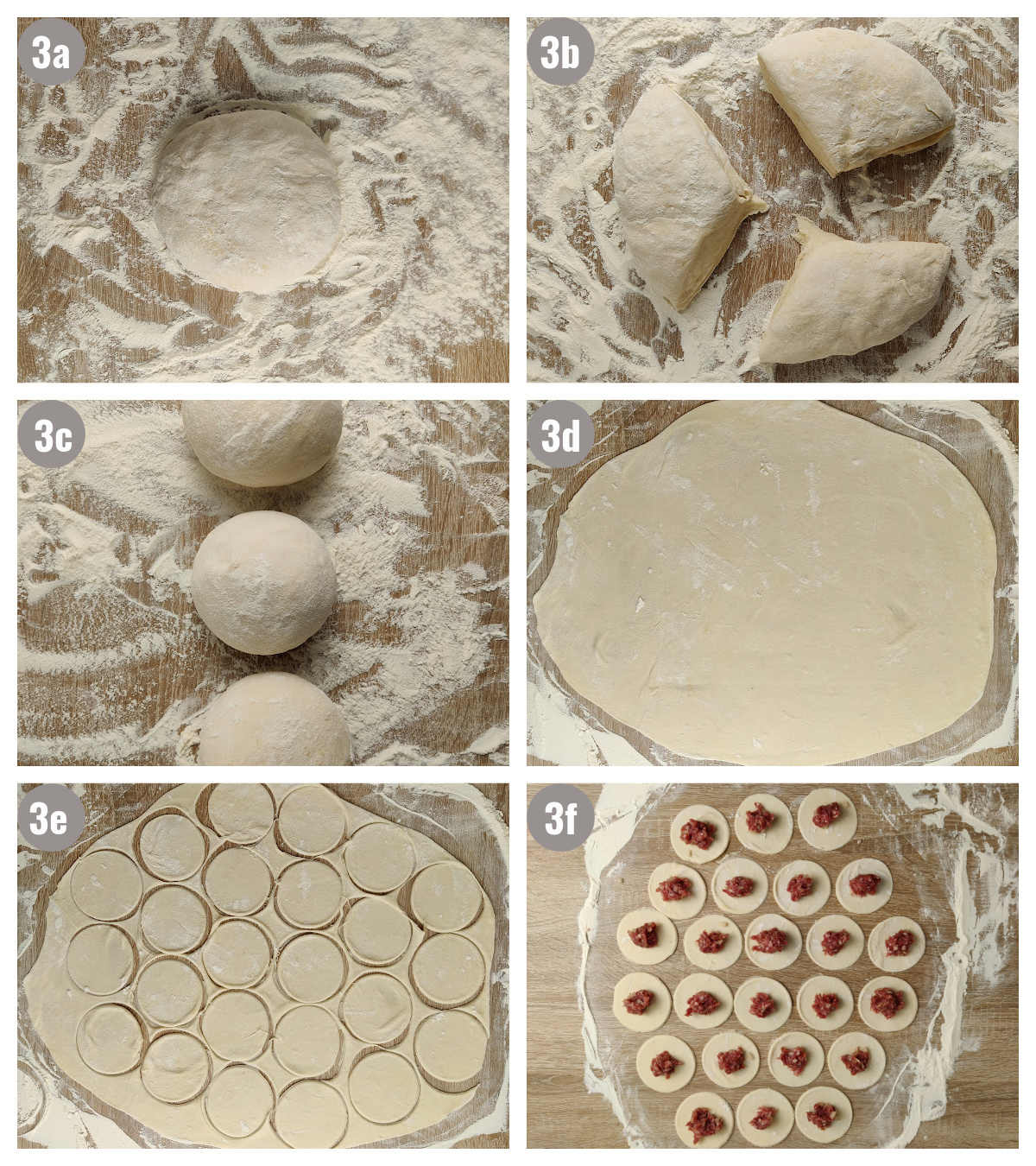
3. (Shaping klepe, crescents) Divide dough into three equal parts. Knead each for three minutes on flour-dusted working area. Roll it out. Cut circles with glass (or ravioli stamp). You'll have 25-30 per dough ball (75-90 total).
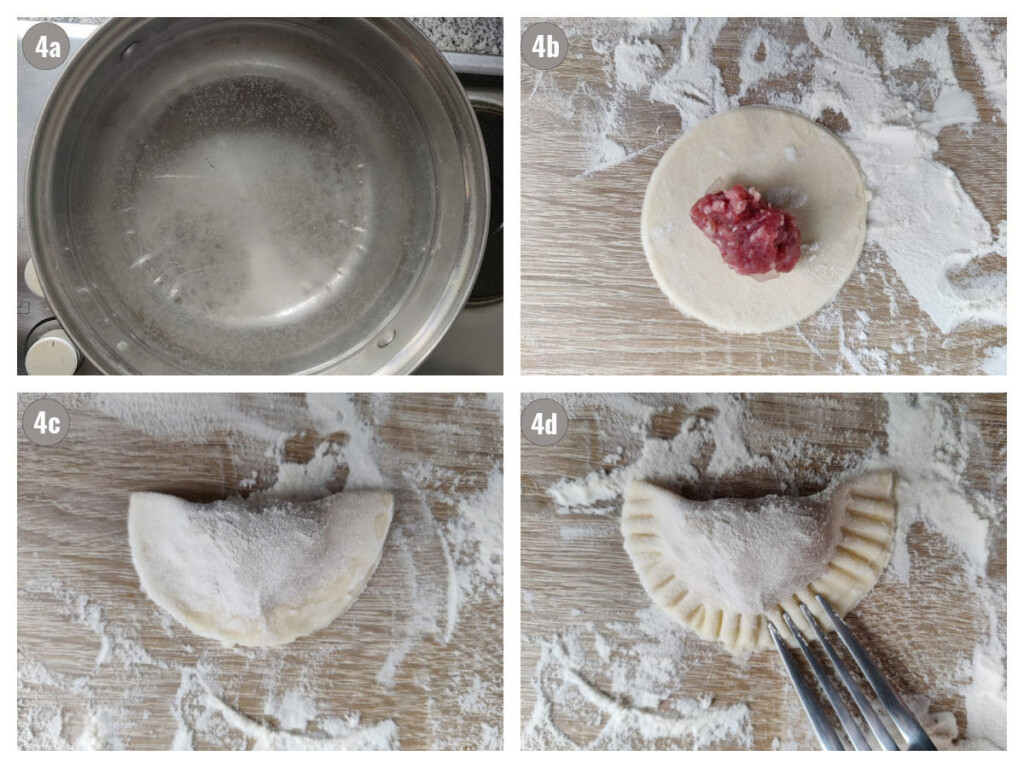
4. (Water, filling) Bring a big pot of water to a boil. Stuff each dough circle. Close it making a crescent. Use a fork to seal ridges. Repeat steps 3 and 4 for all dough and filling.
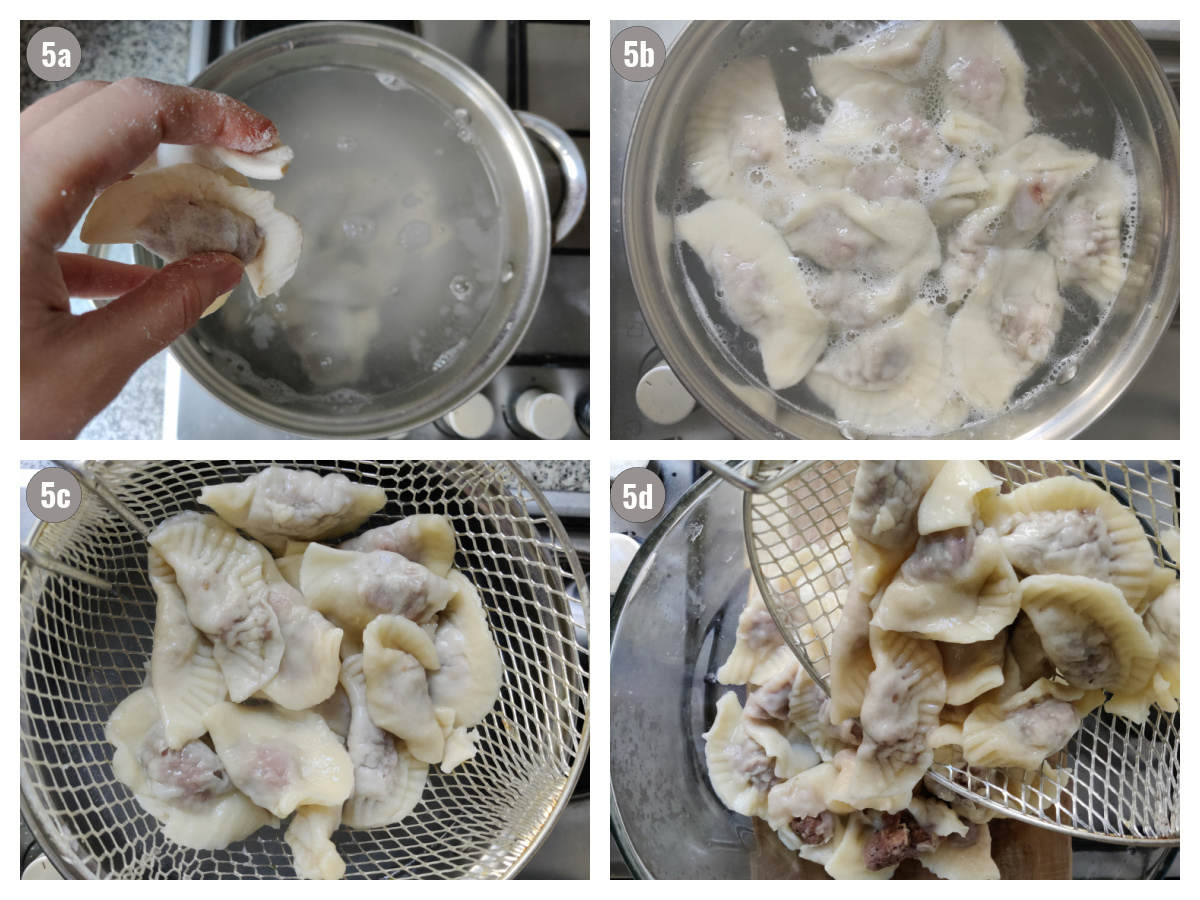
5. (Cooking klepe) Drop klepe into the boiling water in batches. Don't overcrowd. Cook about 12 minutes. Take out, drain, place in baking pan (glassware). Repeat for all klepe. Heat stove to 400°F (200°C).
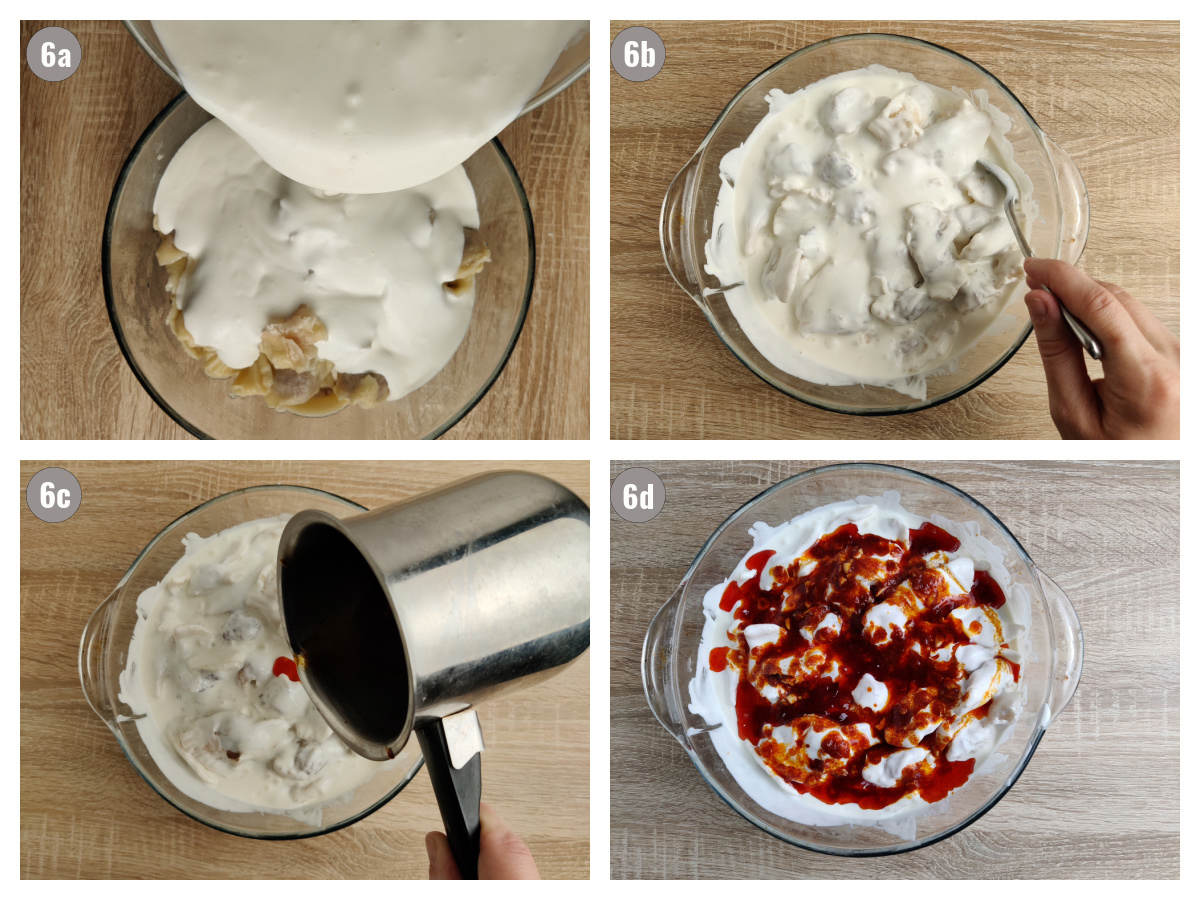
6. (Sauces) Make sauces. Pour sauce 1 into baking pan (glassware) over klepe. Stir carefully. Pour sauce 2 over the top. Bake (not pictured).
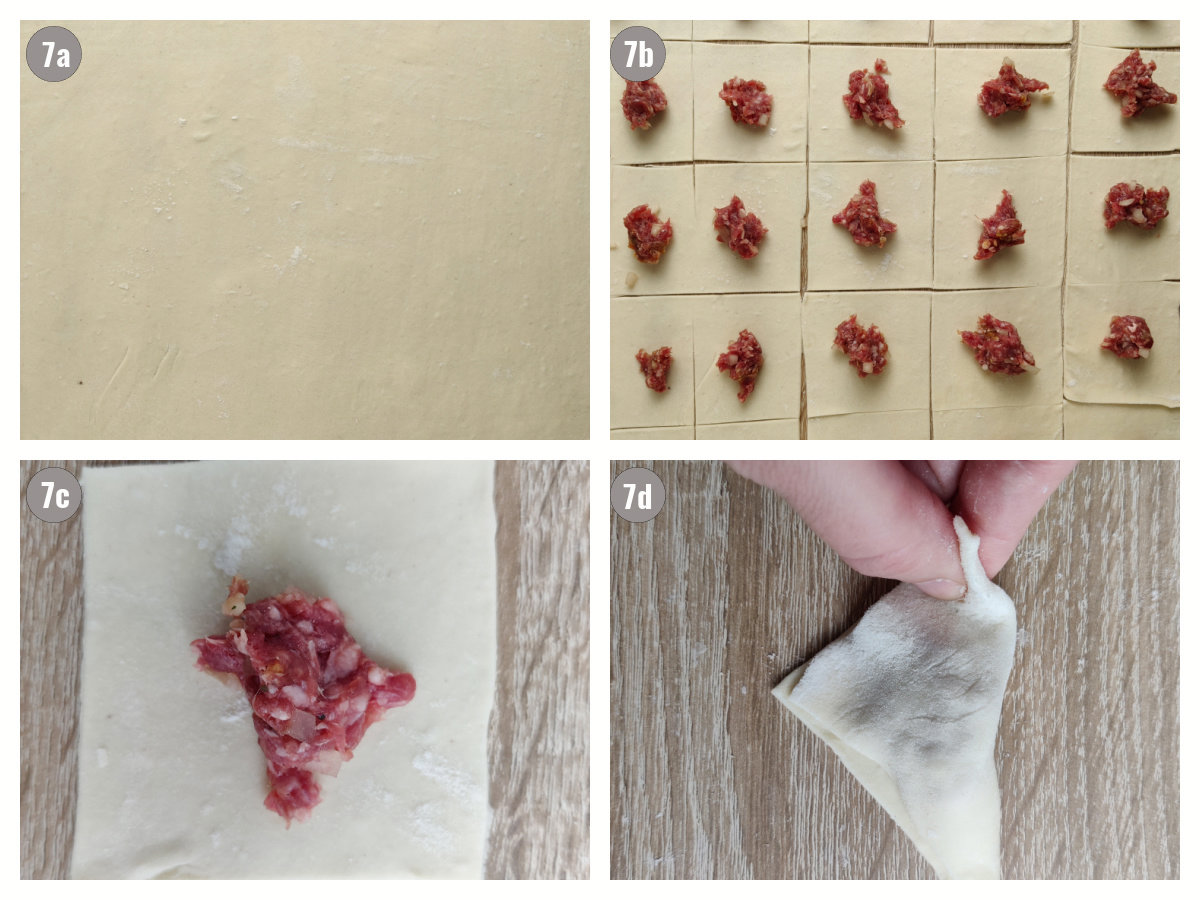
7. (Alternative way to shape klepe: triangles) After you roll each dough roll out, cut it into 25-30 squares. Stuff with the filling and close. Press with fingers to seal. The rest is the same.
Frozen Dumplings (Klepe)
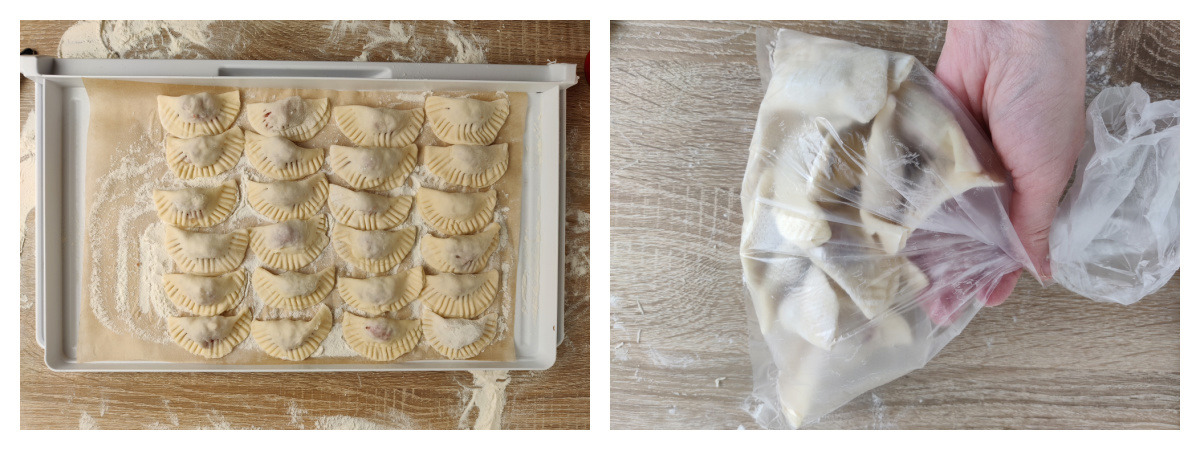
How to freeze your klepe dumplings:
- If planning to freeze klepe, the time to do so is after you stuff the dough, but before you boil them.
- After forming the dumplings, place them on a tray really well dusted with flour. Don't overcrowd them. (Klepe should not be touching each other!) Transfer to a freezer for at least 30 minutes (60 minutes is better!). Depending on the size of your freezer, you may have to freeze klepe in batches.
- At this point, take the tray with your frozen dumplings out, and divide them into portions. Place each portion of frozen dumplings into a freezer container, or a freezer bag that's also been well dusted with flour. (This will prevent sticking.) Then return klepe to the freezer for up to 3 months.
- When you are ready to make your frozen dumplings/ klepe, take them out of the freezer about 10-15 minutes before your water boils. Follow the instructions from there. Don't take them out too early because they may become soggy. Don't take them out too late because they may break in case they got stuck together in the freezer.
Handling
Serving: serve warm, with homemade bread and a side salad.
Storing: Keep baked klepe in the fridge for up to 24-48 hours. (Never leave uncooked klepe in the fridge as they'll get soggy. If you won't make them right away, then follow the freezing directions above.)
Reheating: reheat beef dumplings only once, using your preferred method. Add more sour and/or heavy cream if needed.
Expert Tips
- This is an intermediate to advanced recipe. You'll need patience, several hours, and some skill to make klepe (beef dumplings) happen.
- Klepe, beef dumplings is not a dish you should be making for the holidays if it's your first time.
- Because of the necessary effort, you're best off making 2-3 batches of beef dumplings at the same time and then freeze the extra batches.
- Finally, the serving size for our beef dumpling recipe is quite generous. Therefore you can easily freeze some even if you're only making one batch.
Similar Recipes
Want to test your dough-making skills further? Here are a few recipes:
- Traditional pita (Balkan pie): step-by-step instructions for making phyllo dough with a savory stuffing.
- Sarajevo pizza is a great Balkan take on a pizza. Unconventional, yet delicious!
- Of course you must learn to make bread! You have no excuse now.
- Pastries in a form of strudel might be more of your cup of tea if you've got a sweet tooth.
Thoughts?
If you made Bosnian ravioli also known as the minced beef dumplings (klepe, kulaci), and liked it, please consider giving it a ⭐️⭐️⭐️⭐️⭐️ (5-star) rating. This helps others find the recipe more easily!
Also, feel free to leave a comment (I read each one!), and don't forget to tag a photo #balkanlunchbox, or us @balkanlunchbox, on IG.
Prijatno and bon appetit!
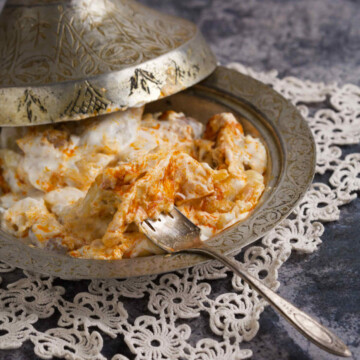
Klepe: Bosnian Ravioli (Manti) Beef Dumplings
Ingredients
Klepe dough:
- 1 pound flour plus more for dusting
- ½ teaspoon salt
- 12-14 ounces warm water approximately
- (Optional) an egg
Klepe filling:
- 1 pound ground beef
- 1 onion minced finely
- 1 teaspoon ground pepper
- 1 tablespoon Vegeta or bouillon powder, or 1 crushed bouillon
- (Optional) two, three cloves of garlic minced
Sauce 1:
- 14-16 ounces sour cream
- 14-16 ounces heavy cream
Sauce 2:
- 3-4 garlic cloves minced
- 1 teaspoon paprika
- 3 tablespoons butter melted
Instructions
Klepe dough:
- In a large bowl combine flour, water (a little bit at a time), salt, and egg (if using it). Start kneading the ingredients, first with a spatula and then with your hands. Continue kneading until you have an elastic, smooth ball. This will take several minutes. (The longer you knead it, the easier it will be to work the dough later.) Once the dough is ready, wrap it in saran wrap and leave it to rest for at least 30 minutes (the longer, the better).
Klepe filling:
- In a smaller bowl combine filling ingredients with your hands, and mix until completely integrated. Divide into three equal portions.
Shaping klepe one way (crescent-moons):
- Dust your working surface with flour generously. Divide dough into 3 smaller, equal, dough balls. (You can use a digital scale to weigh each dough if you want to be super precise, but this is not a must.)
- Take one dough ball and knead it for about 2-3 minutes, then roll it out with a dusted rolling pin. It should be the thickness of about 1-2 stacked coins, or the length of about 15x18 inches (38x46cm).
- Using an upside glass (with about 3-inches in diameter), or a ravioli stamp, cut out as many circles next to each other as you can. Each dough ball, when kneaded and rolled out, should make roughly 25-30-ish dough circles/ dumplings. (Keep the dough that's left in between the circles. Later you can combine all of them, knead them together, and roll them out for a few more dumplings.)
- Meanwhile, in a big pot pour water about ¾ of the way up. Bring to a boil.
- Take one filling part, and fill each dough circle with approximately 1 teaspoon of the filling. Close the circle by taking one half and flipping it over the meat, until it meets the edges of the other half. At this point press the edges together tightly making a half-moon shape. (If working with a ravioli stamp place each circle with the filling in the stamp and close it. This will seal it together and make little ridges on the edges.)
- Take a fork, and form ridges on the edge of each dumpling by pressing it along the edges. (See photo!) (If some filling is left over keep it for the dough you'll make from leftover parts.)
An alternative way of shaping klepe (triangles):
- If the circles sound complicated, you can make triangles instead. (They're easier, but not as pretty.) After working with a dough ball, roll it out into the shape of a large rectangle. Using a knife cut the dough into parallel strips (about 2 inches/ 5 centimeters in thickness). Then cut these stripes perpendicularly, again at about 2 inches until you get about 25-30 squares/ dumplings. Fill each square with approximately 1 teaspoon of the filling. Flip one side of the triangle over the meat. Seal the edges of the triangle together. (Press firmly with the fingers to ensure it's sealed.) Do the same with all three dough balls.
(Optional) If freezing:
- Freeze dumplings after they're formed and stuffed, but before they're cooked. (You may have to do it in batches if your freezer can't hold all trays). Dust a tray generously and layer dumplings next to each other (not touching!) Freeze for 30-60 min. (This step is so they harden and don't glue to each other.) Take them out of the freezer, portion out, and layer them in freezer bags or containers, making sure they are also well dusted with flour.
- When you're ready to make the dumplings, take them out about 10-15 minutes before your water boils. This way they'll thaw just enough that you can separate them easily from each other, but not so that they'll break, or melt. (We're talking about 10-15 minutes or so. Do not leave them out longer, or they'll get soggy! If you take them out too late, they may break) The rest of the process is the same as below.
Cooking klepe dumplings:
- (You can do this step parallel to shaping the dumplings or wait until all the dumplings are shaped and stuffed with the filling.) Drop the first batch of dumplings into the boiling water and lower the temperature to medium high. (Best to use a strainer in the pot, that way you can take all, or most, of them out at the same time.) Leave them in boiling water for 10-12 minutes. Even though they'll probably pop up earlier than that, it's imperative they cook at least that long, otherwise the meat will be undercooked. Do not overcrowd the pot. It's better to do several batches than to have them all glue to each other. You can give them a stir once or twice. Some will fall apart, and that's ok. Heat stove to 400°F (200°C).
- As they're done, layer the batches of klepe/ dumplings on top of each other in a glass bakeware.
Sauce 1:
- In a bowl, whisk the ingredients for the sauce one 1 together until integrated. Pour evenly over the dumplings, distributing it over all the layers. You may have to stir the dumplings, but do it lightly so they don't fall apart.
Sauce 2:
- In a small pot heat up ingredients for sauce 2. Pour evenly over the top of the dumplings. (This sauce stays on top.)
Baking klepe dumplings:
- Place glassware on medium rack in the oven for 15-20 minutes.
- Serving: serve warm, with homemade bread and a side salad. Storing: Keep baked klepe in the fridge for up to 24-48 hours. (Never leave uncooked klepe in the fridge as they'll get soggy. If you won't make them right away, then follow the freezing directions above.) Reheating: reheat only once, using your preferred method. Add more sour and/or heavy cream if needed.


Aida says
Aaa yum, klepe! I instantly clicked on this as it takes me back to my childhood, my Mum would always make this for my brother and I. It's a delicious and simple dish made with love, which represents our Bosnian cuisine! It's a coincidence that we both have the same name and share the same love for our Bosnian food, people and culture:). Ms. Ifeta's heart-warming story connects me with numerous tales of my parents and family who also survived the horrible war and especially the siege of Sarajevo. It only made them stronger and nothing can kill off their wish to live and appreciate all of the little things in life even more. It's up to us to continue the wonderful spirit of Bosnian culture and I congratulate you on your amazing blog that shows off all of our delicious meals and traditions. Your pictures are beautiful and they are the biggest invitation to all visitors of your blog. Your detailed recipes of traditional dishes invite us to try and experience a cuisine that is not so well known and explored, but memorable for anyone who has tasted it. Good luck and best wishes from your fellow Bosnian, Aida xx
Aida says
Well hello there Aida, a lovely girl with the same name!
Thank you for your kind words-they brightened up my day. Klepe are some of my favorites, I could eat them and eat them.
Also, glad you too are joining the food blogging ranks. We need more of us to write some of this stuff up for the English speakers. I really do believe Bosnian, (and Balkan cuisine in general) is one of the best in the world, easily comparable to the richness of French cuisine. It's a shame this is not as widely known, so it feels nice that we are making a little bit of a difference on that front. I look forward to reading your recipes and blog! Thanks again for stopping by. <3 Aida
Aaron says
I had wonderful klepe in Sarajevo on my travels, in this beautiful restaurant over a florist shop. I'm working my way through the 195 countries of the world cuisine by cooking a meal from a different country each week. Today is klepe and I've invited a friend over to experience the wonder that is Bosnian cuisine. I am so excited! Thank you for your blog!
Aida says
Aaron,
That's wonderful! Glad you had a chance to visit Sarajevo.
How did they turn out?
Lily says
I made this recipe for my family and it tasted amazing! We’ve never had Balkan cuisine before, it was a lot of work but it turned out great. Thank you Aida!
Aida says
Lily,
we are so glad that you and your family liked it!
Kudos to you for trying out Balkan cuisine by making a quite an advanced recipe.
Happy cooking!